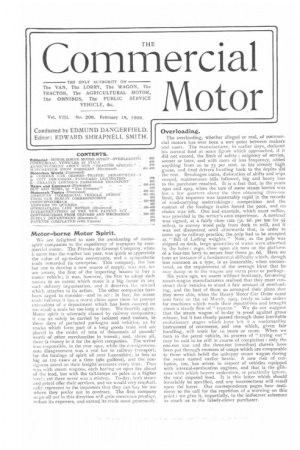Overloading.
Page 1

If you've noticed an error in this article please click here to report it so we can fix it.
The overloading, whether alleged or real, of commercial motors has ever been a sore point between makers. and users. The manufacturer, in earlier days, declared his normal load at some figure which approached, if it did not exceed, the limit of safety : exigency of service, sooner or later, and with more or less frequency, added anything from 20 to 75 per cent. to his already high guess, and tired drivers hustling back to the depots did the rest. Breakages came, dislocation of shifts and trips ensued, maintenance bills followed, big and heavy loss to he purchaser resulted. It is a fact that, in the years 1902 and 1903, when the tare of some steam lorries was but a few quarters above the then obtaining three-ton limit, this se9uence was lamentably rapid in the records of road-carrying undertakings : competition and the custom of the haulage trades forced the pace, and no choice was left. One bad example, which must suffice, was provided in the writer's own experience. A contract was signed, at a fairly close rate (3s. 6d. per ton for 9i miles), to convey wood pulp from dock to mill, and it' was not discovered until afterwards that, in order to come up to railway practice, the pulp had to be accepted at " Bill of Lading weights." Now, as the pulp was shipped on deck, large quantities of water were absorbed by the bales : ergo, close upon six tons on the platform of a four-ton lorry to secure four times 3s. 6d. Here we have an instance of a fundamental difficulty which, though less common as a type, is as inexorable, when encountered, as the requirement of the average hirer that he may dump on to the wagon any extra piece or package.
Six years ago, we assert without hesitancy, far-seeing steam-wagon manufacturers realised that they must construct their vehicles to stand a fair amount of overloading, and the best of them so arranged their plans that they were able, when the Heavy Motor Car Order came into force on the 1st March, 1905, freely to take orders for machines which made their reputations and brought about a steady flow of "repeats." We do not suggest that the steam wagon of to-day is proof against gross misuse, but it has clearly passed through those inevitable evolutionary stages which have left it a workmanlike instrument of commerce, and one which, given fair handling, will work for to years or more. When we turn to the petrol vehicle, its process of "trying out " may he said to be still in course of completion : only the one-ton van and the three-ton (omnibus) chassis have been put through excesses of usage which are comparable to those which befell the unhappy steam wagon during the years named earlier herein. A new risk of confusion, too, has arisen in respect of vehicles equipped with internal-combustion engines, and that is the glibness with which buyers understate, or practically ignore, the total imposed load. It is this latter which should invariably be specified, and any incorrectness will recoil upon the buyer. Our correspondence pages bear testimony to the call for the repetition of a warning on this point: we give it, impartially, to the indiscreet salesman as much as to the falsely-clever purchaser.
























